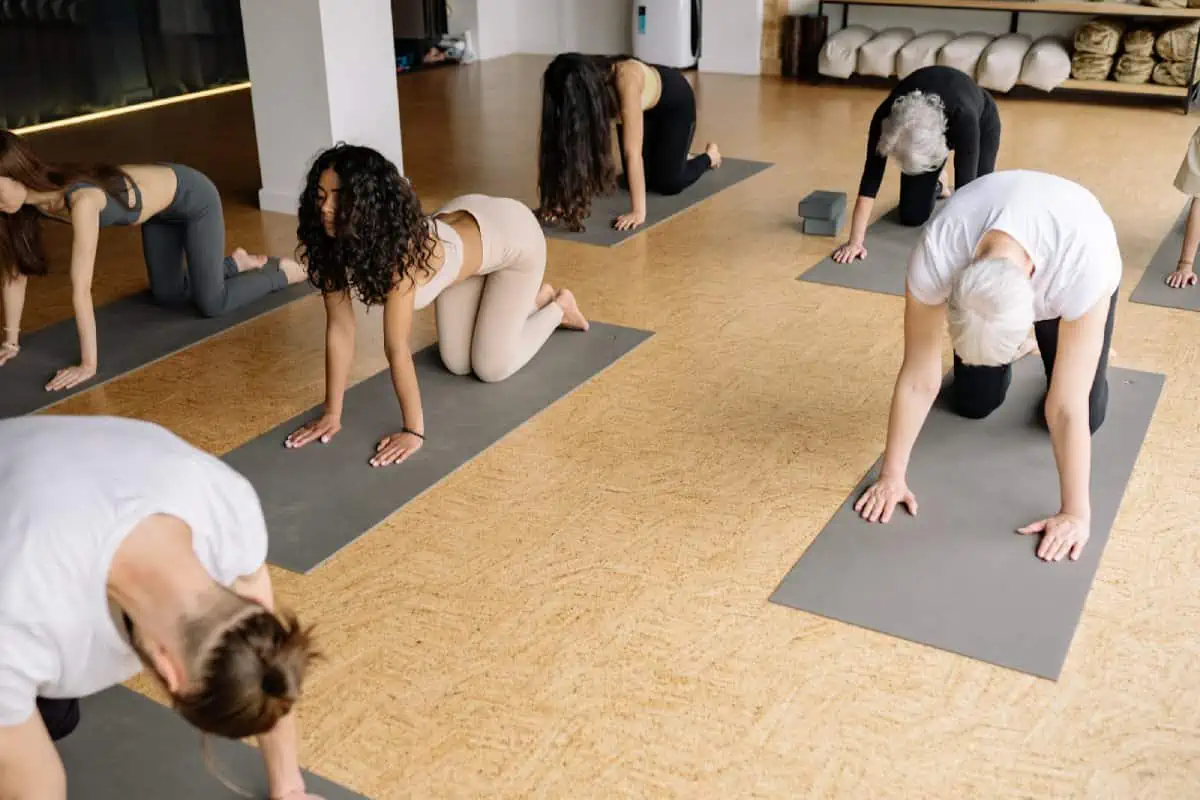Key Takeaway
Cat-Cow Pose is an essential, adaptable yoga asana that enhances spinal mobility, alleviates back pain, and reduces stress through synchronized breath and movement.
| CAT-COW POSE | |
|---|---|
| Alternate name: | Marjaryasana-Bitilasana |
| Difficulty level: | Beginner |
| Pose category: | Kneeling |
| Muscle groups: | Erector spinae (back) Abdominal muscles (abdomen) Rectus abdominis (abdomen) Transverse abdominis (abdomen) Obliques (abdomen) Psoas major (hip flexors) Gluteus maximus (buttocks) Serratus anterior (shoulder girdle) Rhomboids (upper back) Trapezius (upper back) Scapular stabilizers (shoulder girdle) |
| Physical benefits: | Increases flexibility and relieves tension in the spine. |
| Therapeutic applications: | Alleviates lower back pain, Reduces anxiety. |
| Preparatory poses: | Easy Pose (Sukhasana) Child’s Pose (Balasana) |
| Counterposes that follow well: | Thread the Needle Pose (Parsva Balasana) Sphinx Pose (Salamba Bhujangasana) Downward Facing Dog (Adho Mukha Svanasana) |
| Chakras activated: | Sacral Chakra (Svadhishthana) |
| Most helpful prop: |  Folded blanket under knees - cushions and supports joints. See latest price |
On those busy days when you can’t make it to a yoga class, and have time for just one yoga pose to help melt away the day’s stress — which asana would you choose?
Our recommendation is the most classic pair of poses: Cat-Cow Pose! When we talk about “Cat-Cow Pose” here, we are referring both to the individual postures of Cat Pose and Cow Pose, and how you move between the two poses. Cat-Cow is a foundational pose that is usually practiced at the beginning of a yoga class to warm up the body in preparation for asana practice.
Correct alignment of the spine is a vital element in yoga (especially in Iyengar yoga), in order to practice safely and prevent injury. For students just beginning their yoga journey, cat-cow pose is a fantastic introduction to the powerful connection between breath and movement.
When practiced regularly, the benefits of Cat-Cow Pose extend far beyond the spine. Luckily, this pose is incredibly adaptable and easy to practice even if you’re on the go. Keep reading our in-depth look at Cat-Cow Pose to discover just how amazing this asana can be for your well being!
Contents
Benefits of Cat-Cow Pose
Each of these two poses offers many benefits on their own. When paired together using synchronized breath movement, the positive effects are even greater. Here are some of the main reasons why we consider this pose indispensable to your yoga practice. Cat-Cow Pose:
- Gently mobilizes the spine
- Stretches the muscles of the back
- Stretches the abdominal muscles
- Massages the abdominal organs and softly stimulates digestion
- Alleviates lower back pain
- Builds breath awareness
- Reduces anxiety
- Increases blood flow
- Reduces pain from menstrual cramps
- Helps develop postural awareness
- Relieves tension in neck, shoulders, and spine
Let’s take a closer look at a few health concerns and how this asana might help both your body and your mind.
Experiencing pain? Cat-Cow can bring relief!
Unfortunately, today’s tech-focused world results in a sedentary lifestyle for many of us, with too much time sitting in front of a computer or commuting to work in a car. Aside from the usual aches and pains it brings, too much sitting is linked to slowed metabolism and impeded blood flow.
After periods of sitting, a bit of gentle yogic movement like Cat-Cow Pose gets your blood flowing again. Even if you are stuck at a desk, practicing a seated variation of Cat-Cow helps boost circulation and reduces stiffness.

One of the most prevalent ailments people complain about is lower back pain. If this sounds like you, try adding in some yoga to your daily health routine. One study in particular showed that after 12 weeks of practicing Hatha yoga, two-thirds of the participants reported both a decrease in lower back pain as well as decreased use of pain medication.
Individuals with a female reproductive system are surely no strangers to pain. In a study of menstruating teenage girls, Cat Pose specifically proved to be effective in decreasing both the duration and intensity of menstrual cramps.
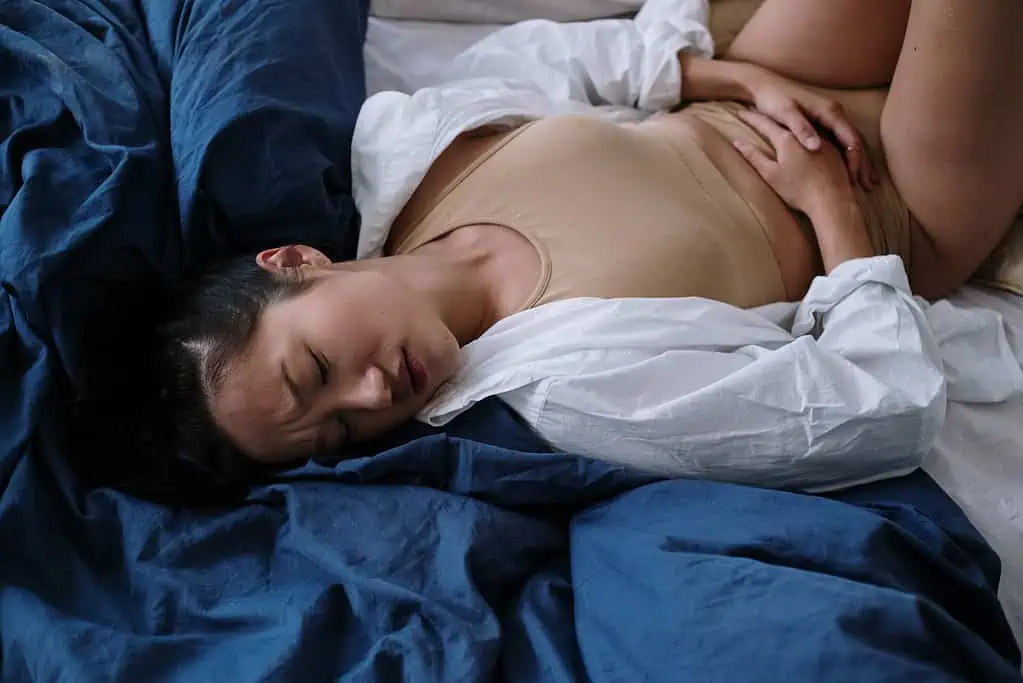
As if all of this isn’t enough, the benefits of Cat-Cow Pose stretch beyond just the physical body.
Feeling anxious? Try this gentle movement.
Not only does practicing yoga improve spinal mobility, it also helps to reduce stress and anxiety. Synchronized breath movement plays a big part in this effect.
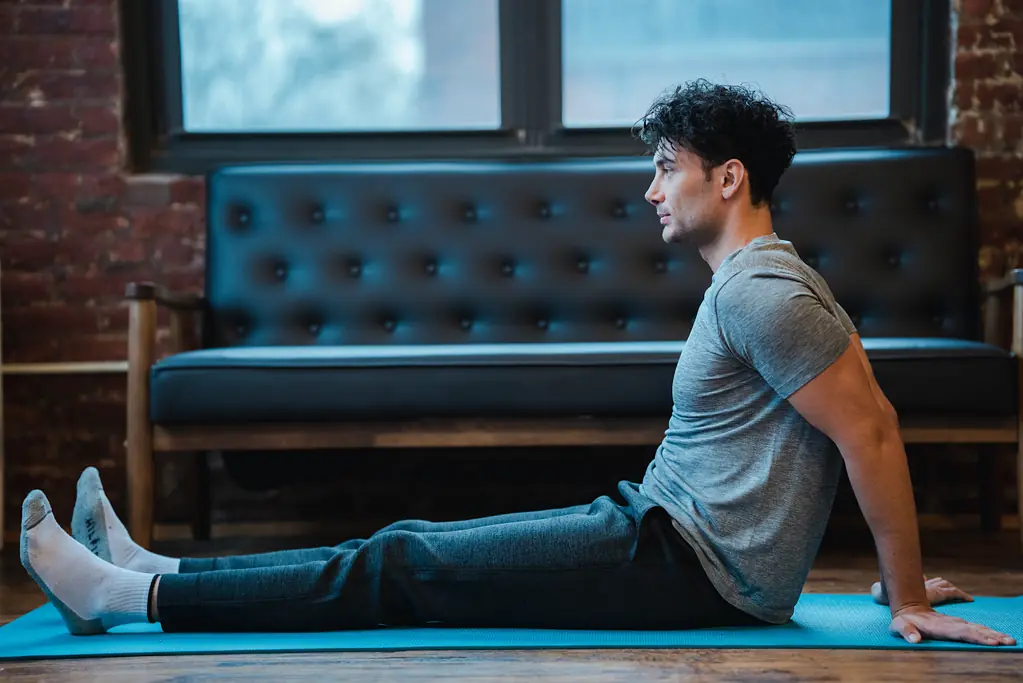
When you pair your yoga asana flow with your breath, you are more likely to slow down and take deeper, fuller inhales. This slower breathing relieves stress by signaling your parasympathetic nervous system to take over and send your body into its “rest and digest” mode, in turn slowing down the heart rate and helping your body calm down.
Practicing Cat-Cow pose increases this calming effect not only through slow, deep breathing, but also by physically reducing tension in the back. When the psoas muscle becomes tight after long periods of sitting, it can compress the adrenal glands, causing a release of the stress hormone cortisol. The result is overactivity of the sympathetic nervous system, keeping your body in “fight or flight” mode.
By focusing on movements that release physical tension like Cat-Cow, you can create positive changes in your mental state and overall well being.
How to Do Cat-Cow Pose
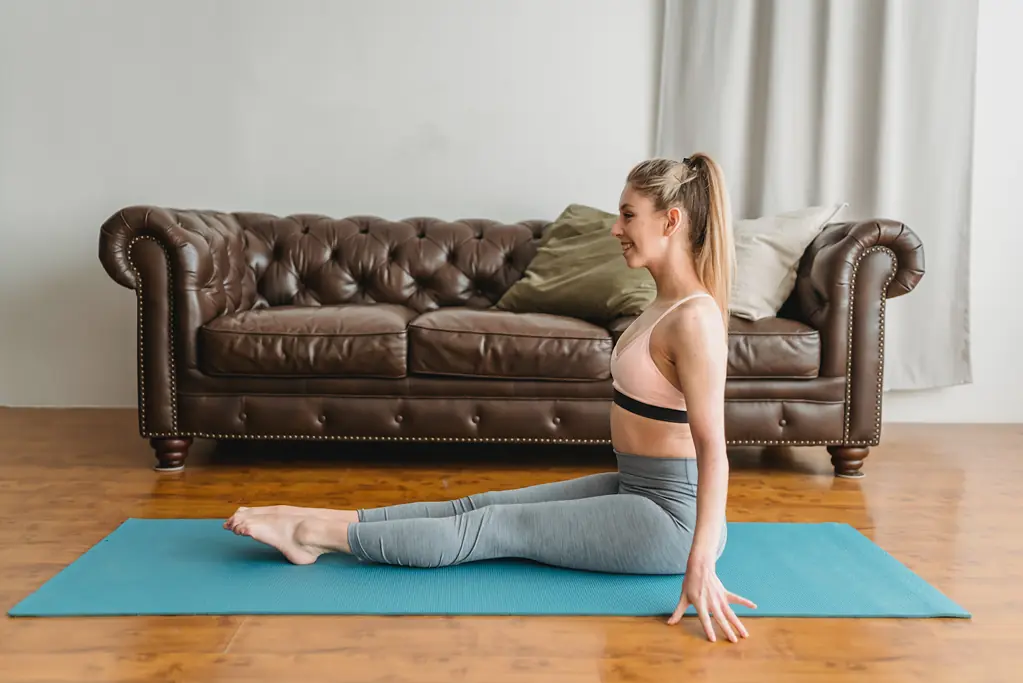
In order to practice correct alignment, we’ve broken down both Cat and Cow pose here separately. Focus your attention on the back side of your body to feel the spinal extension of Cow Pose, and the spinal flexion of Cat Pose. Follow the step-by-step instructions for each pose below; then, put the two poses together in a gentle flow.
Cow Pose (Inhale)
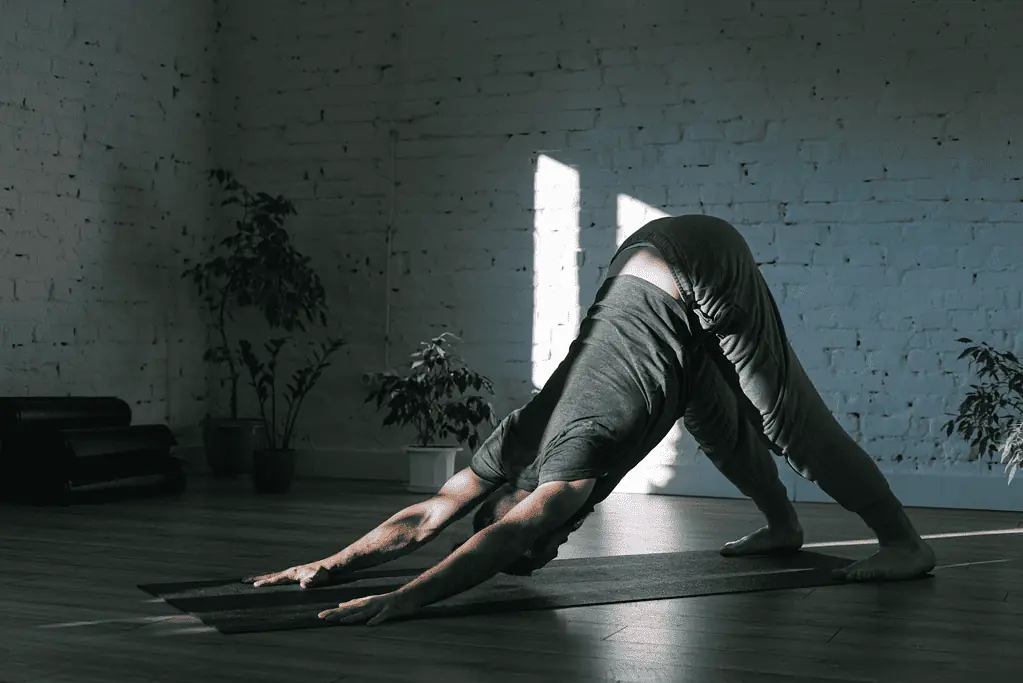
- Begin in a Table Top position. Bring your palms flat on the floor at shoulder distance apart. Align your knees directly under your hips. You may tuck your toes, or keep the tops of your feet flat on the floor.
- Keep your arms straight and as you inhale, let your belly drop. Tilt your pelvis with your sit bones upward.
- Shine your chest forward and draw your shoulder blades together.
- If it feels okay for your neck, lift your chin an inch or two.
Transition from the spinal extension of Cow Pose into spinal flexion with Cat.
Cat Pose (Exhale)
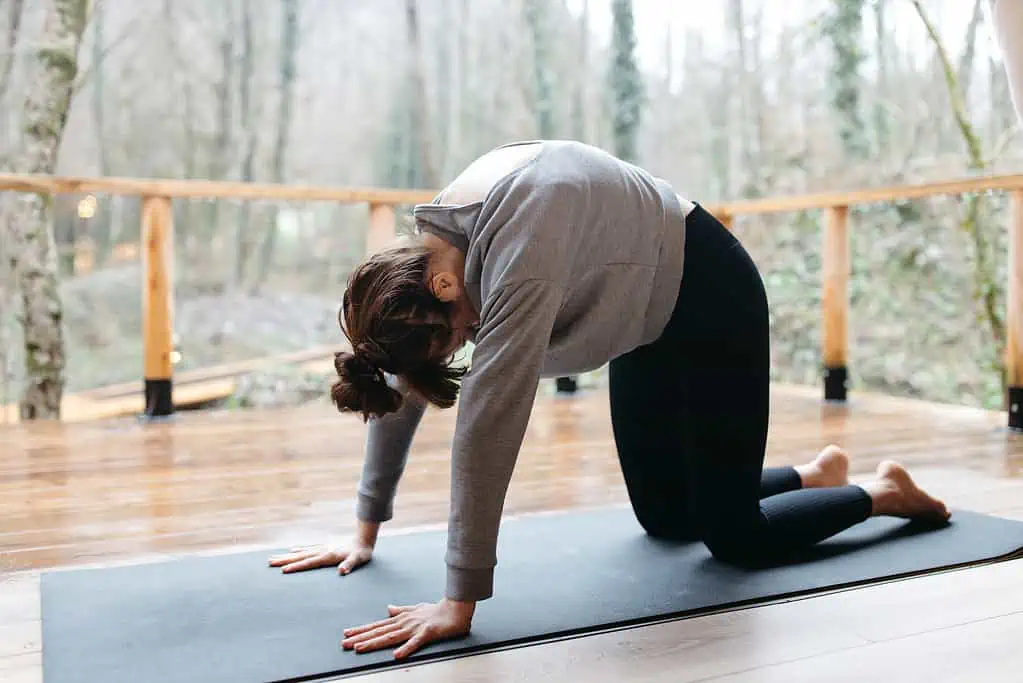
- Keep your hands grounded into your mat and your arms straight.
- With your exhale, round your spine: curl your pelvis underneath yourself.
- Picture making a C-shape with your back, curving your spine outward. Press your belly button in and up towards your spine to give your abdominal organs a gentle massage.
- Spread your shoulder blades wide across your upper back.
- If it feels okay for your neck, drop your head and bring your chin towards your chest.
Now, it’s time to flow!
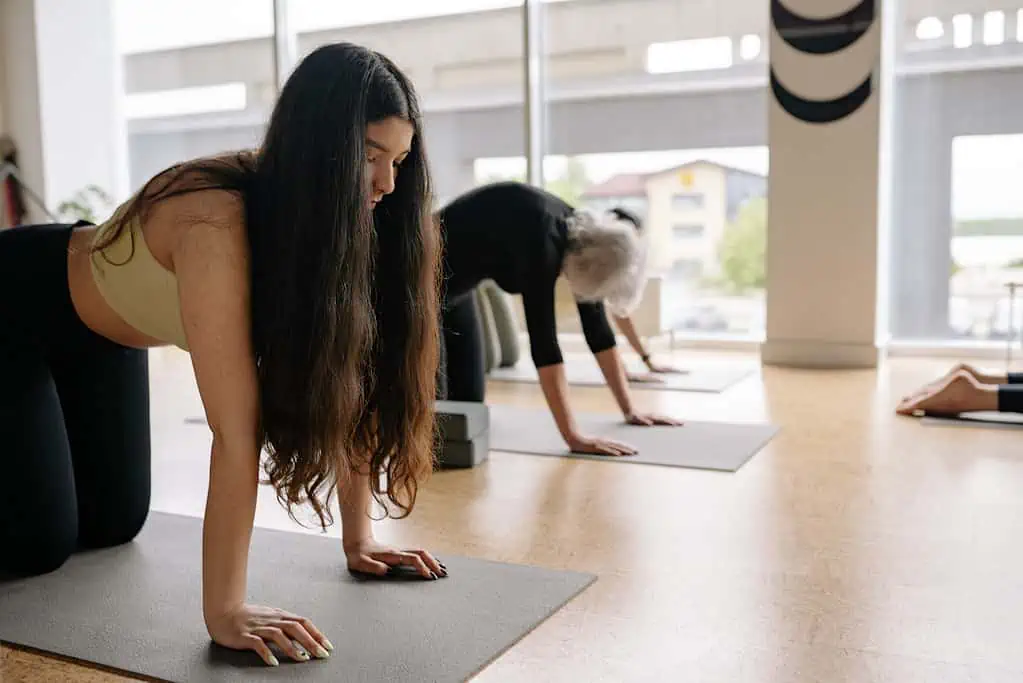
Continue this spinal movement for a few breaths, moving to Cow as you breathe in and Cat Pose as you breathe out. After a few rounds, return your spine and tailbone to a neutral position, then sit back on your heels and rest. Or, continue on with your own yoga sequence (check out some recommended poses below!).
If you prefer a visual guide, take a look at this Cat-Cow tutorial:
Contraindications and Modifications
If you experience any discomfort in Cat-Cow, try these simple modifications to practice the pose with ease.
Wrist pain
There are a couple of ways to alleviate wrist pain in a Table Top position. The first option is to make fists and bring your knuckles to the floor, keeping the wrist and hand in a straight line. Or, you can simply move your hands a few inches forward to decrease the angle of flexion at the wrist.
Sore knees
Using a prop is never a bad idea! If you have sensitive knees, just place a folded blanket underneath yourself for some extra padding.
Neck injury
If you have a neck injury, it is still possible to practice Cat-Cow Pose. Just be sure to keep your head aligned with your spine rather than lifting and dropping your chin. Alternately, try the forearm variation described below so you can isolated the spinal movement to your lower back.
Variations of Cat-Cow Pose
Cat-Cow in a Chair
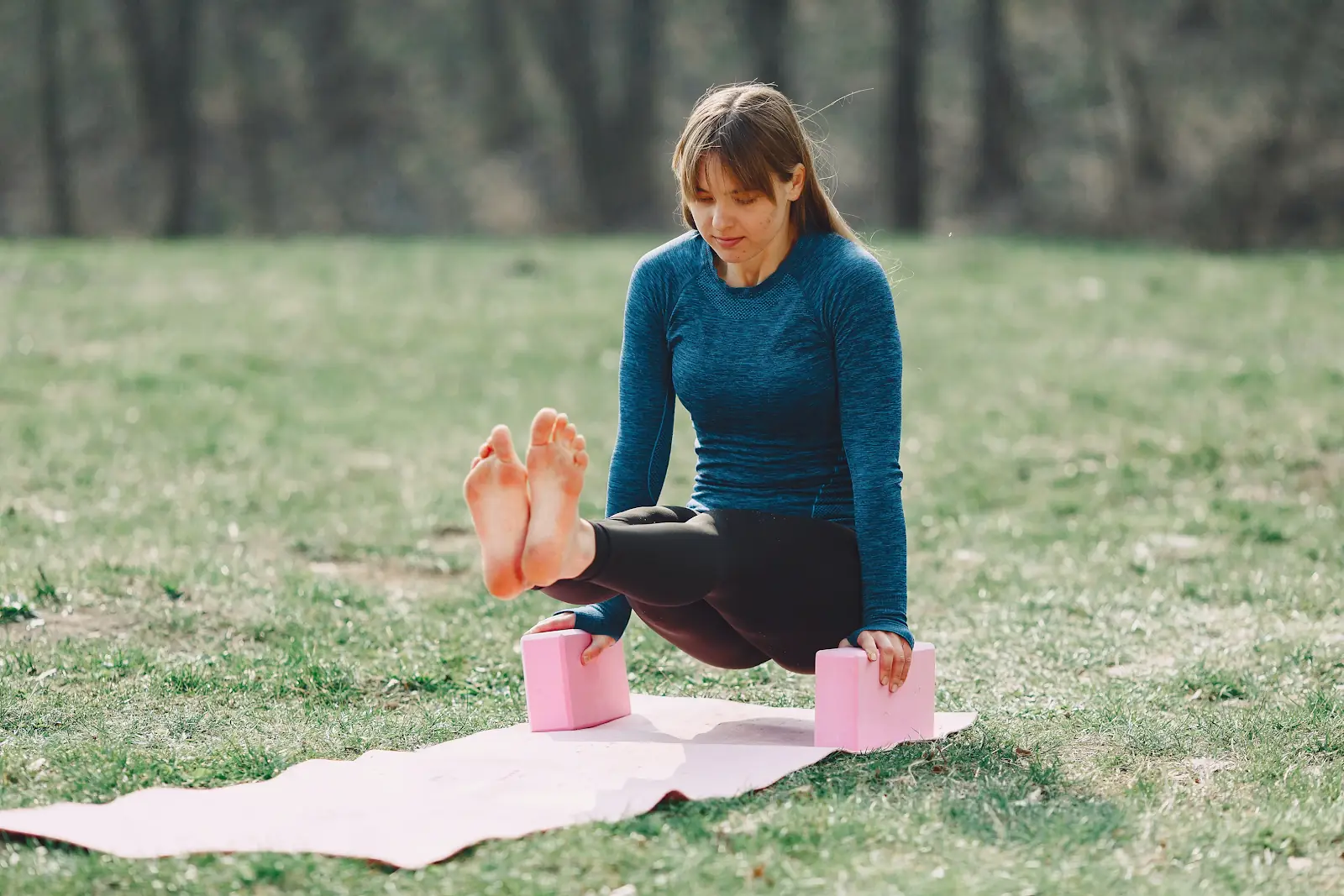
With this variation, you can practice Cat-Cow Pose on the go or in the office. Likewise, if you are unable to bear weight on your wrists or have a difficult time getting down to the floor, this chair yoga version of Cat-Cow is perfect for you!
- Sit in a sturdy chair, a bit forward on the seat so you can plant your feet flat on the floor.
- Place your hands on the tops of your thighs, palms down. Sit up as straight and tall as you can.
- As you breathe in, bring your chest forward. Squeeze your shoulder blades together and lift your chin slightly.
- With your exhale, round your upper back and drop your chin toward your chest.
- Flow between seated Cow and Cat pose for a few breath cycles, then return to your center, in a neutral spine position.
Extended Cat-Cow
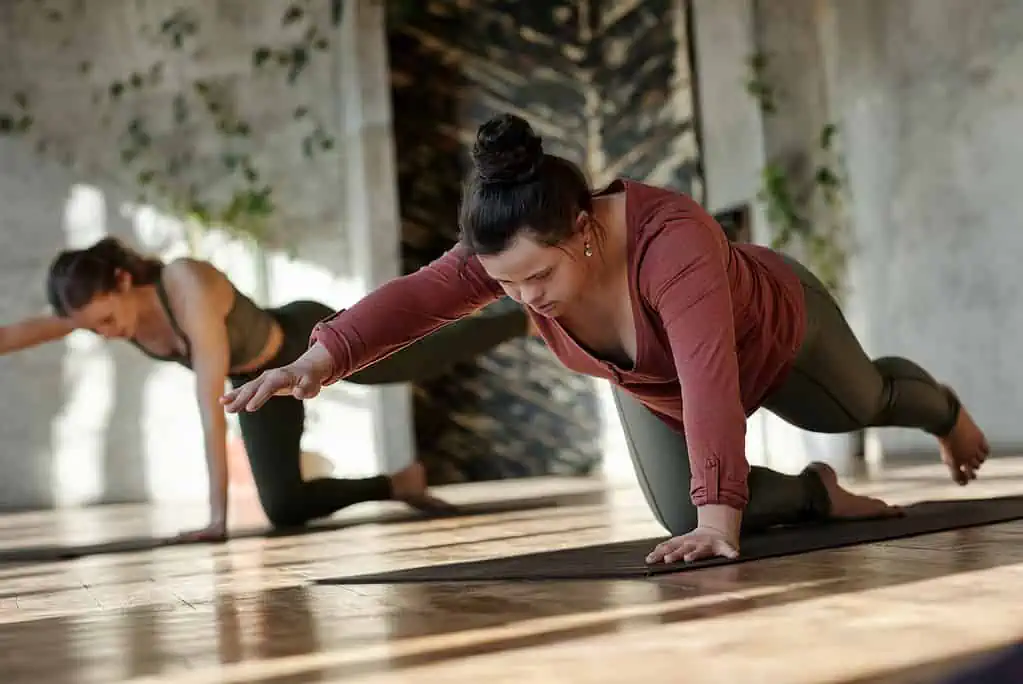
Turn this asana into a core strengthener for an extra challenge.
- Come to a Table Top position on your hands and knees and follow the alignment as described above.
- Engage your core by pulling your belly button in and up, toward your spine.
- Maintain this core activation as you extend your right arm forward and left leg back.
- As you exhale, round your spine and bring your elbow and knee to touch underneath yourself.
- Inhale and return to a neutral spine with your arm and leg extended.
- Complete a few rounds of these Cat-Cow crunches, then release your arm and leg back down to your mat.
- Repeat Extended Cat-Cow on your other side, with your left arm and right leg extended.
Forearm Cat-Cow
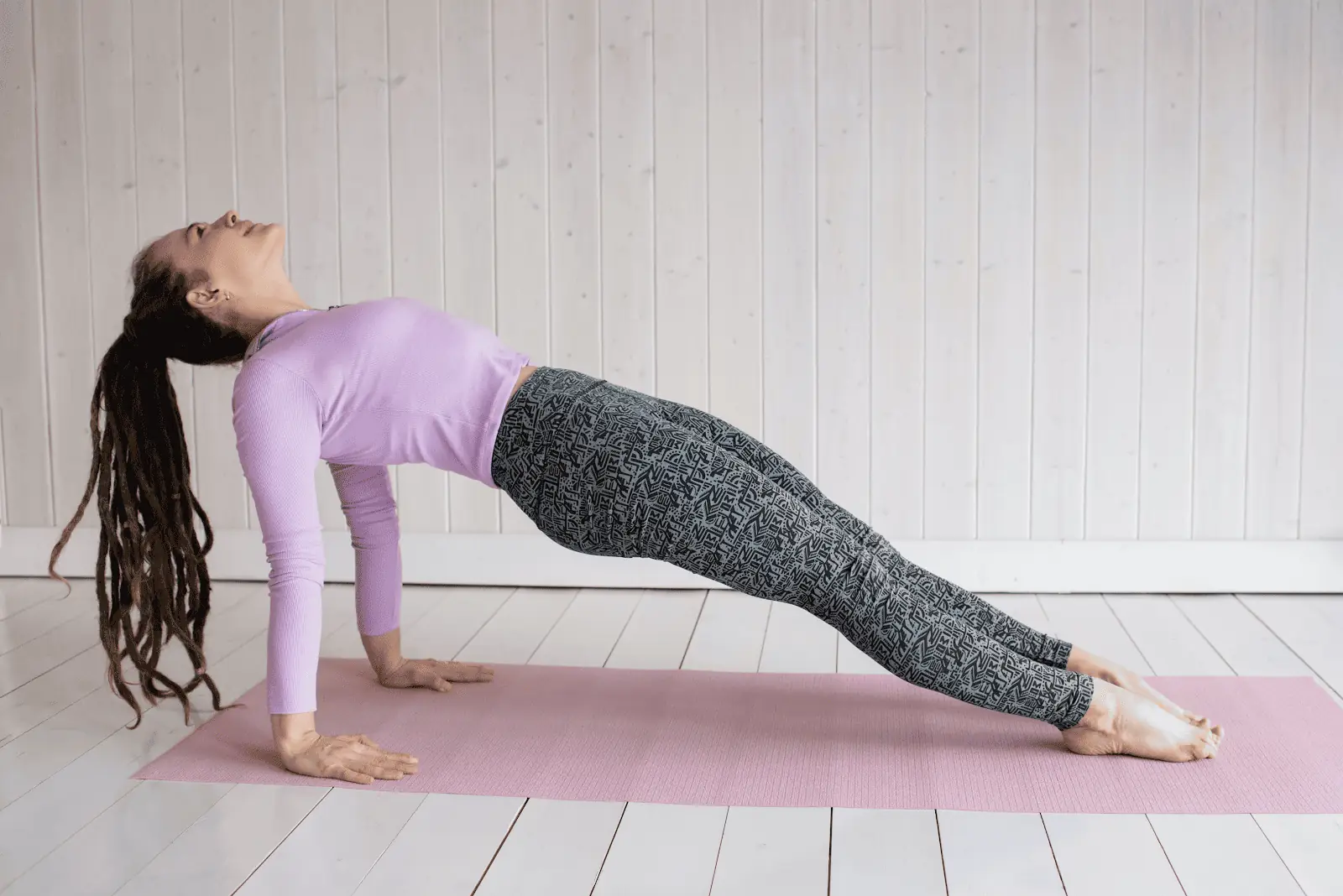
This variation is especially helpful if you’re looking to target your lumbar spine/low back.
- From Table Top, lower yourself down to your forearms. Keep your elbows aligned underneath your shoulders.
- Keep your neck and head stable as you inhale and tilt your tailbone up and back, taking your sit bones toward the sky.
- On your exhale, curl your pelvis forward and underneath yourself.
- Flow with your breath and keep the motion isolated to your lumbar spine as your tailbone emphasizes the movement.
Yoga Poses to Practice With Cat-Cow Pose
Preparatory Poses:
Easy Pose: focus your attention and bring awareness to your body.
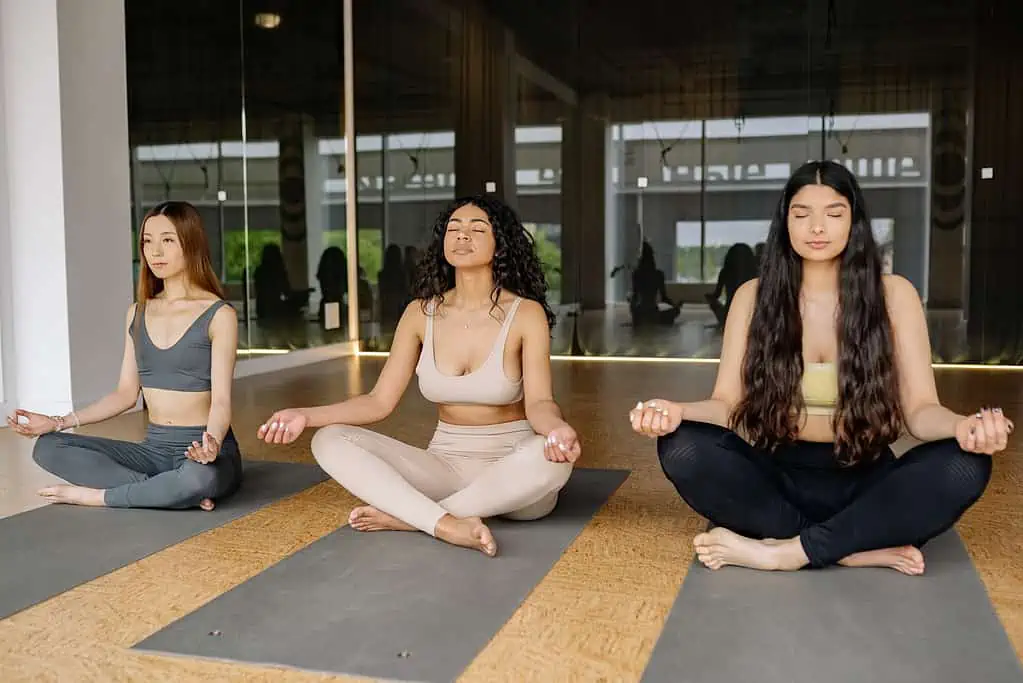
- Sit on your yoga mat in a comfortable cross-legged position.
- Lengthen your spine and sit as tall as you can, reaching the crown of your head up toward the sky.
- Keep your shoulders relaxed down away from your ears.
- Let your hands rest comfortably on top of your thighs, or folded in your lap.
- Close your eyes or lower your gaze to the floor in front of you and focus your attention on your physical body.
- Take a few deep breaths, bring your hands to the floor in front of you and pull yourself forward onto your knees in preparation for Child’s Pose.
Child’s Pose: lengthen your spine and stretch your back in preparation for gentle movement.
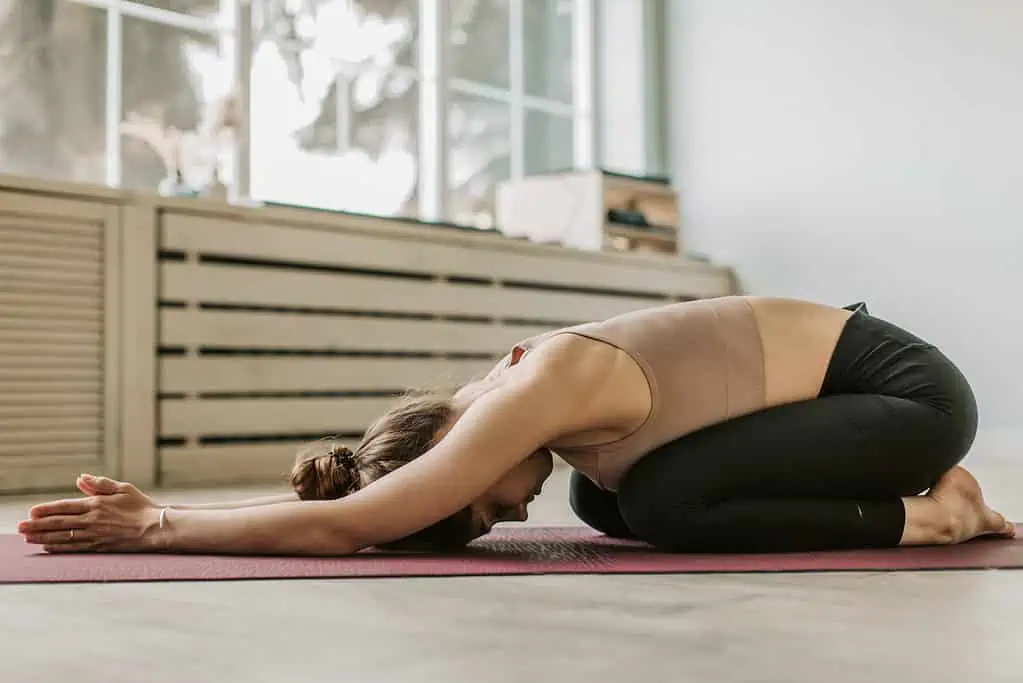
- Begin in a kneeling position. Separate your knees and keep your big toes together.
- Reach your arms forward and bring your head down, resting your forehead on your yoga mat.
- Keep your hands separated at least shoulder width apart.
- Reach your hips back towards your heels.
- Take several deep breaths, focusing on releasing tension in your neck, shoulders, and spine.
Follow-up poses:
After Cat-Cow, the follow-up pose possibilities are endless. But here are a few options of other neck, shoulders, and spine focused poses that follow nicely after Cat and Cow.
Thread the Needle: stretch your shoulders and upper back.

- Begin in Table Top with a neutral spine position.
- Keep your left hand planted and as you inhale, open your chest to your right as you reach your right arm up towards the sky.
- As you exhale, thread your right arm underneath yourself and lower down onto your right shoulder.
- Turn your head to your left and gently place your right ear on the floor.
- Hold this position for a few deep breaths.
- To release, press into your left hand to lift yourself up, and return to Table Top.
- Repeat Thread the Needle stretch on your other side, coming down onto your left shoulder.
Sphinx Pose: open your chest
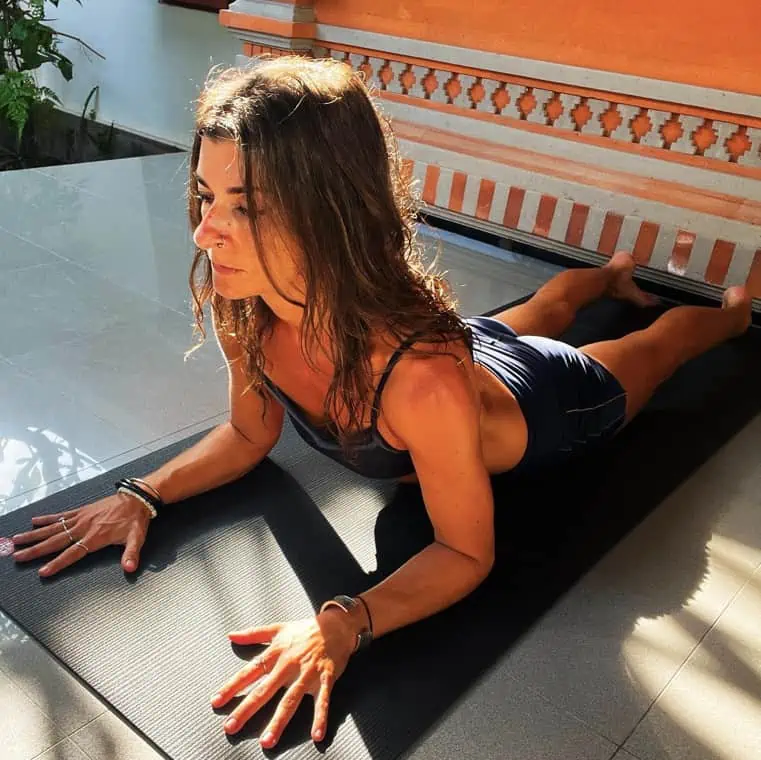
- Begin lying flat on your belly. Bring the tops of your feet to the floor and keep your legs separated about hip-width distance.
- Bring your elbows underneath your shoulders. Press your palms and forearms into your mat.
- Lift your head and chest, shining your heart forward with your collarbones separated. Keep space between your shoulder blades so your upper back is open.
- Try to keep your legs and glutes relaxed as you breathe deeply.
- Hold Sphinx Pose for 5-10 breaths, then gently release yourself back down to your belly.
Downward Facing Dog: lengthen your spine
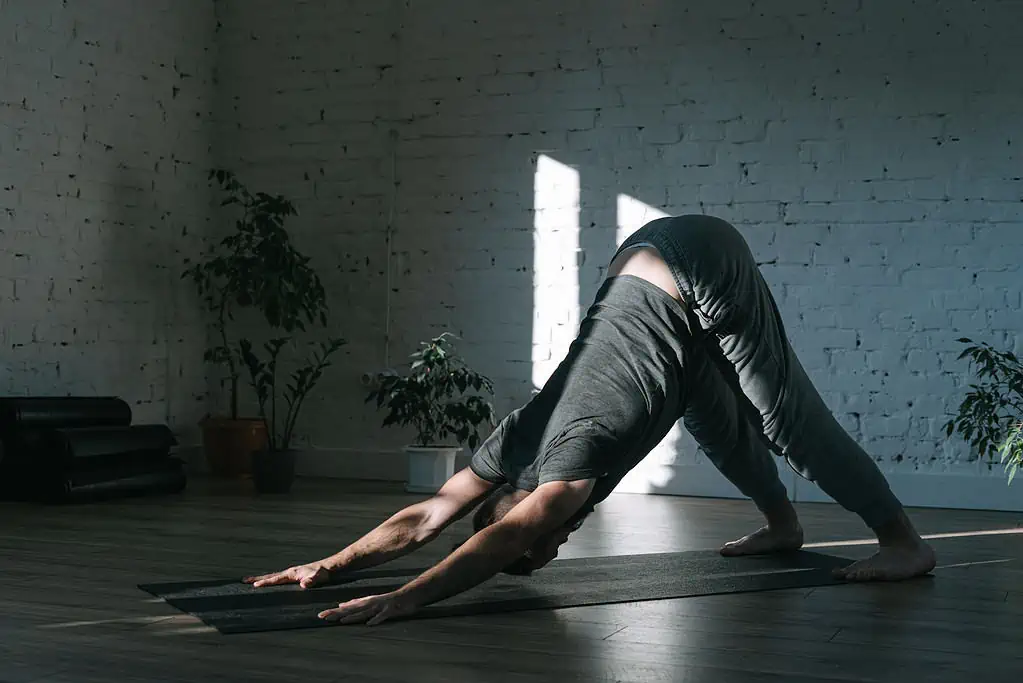
- Begin in Table Top. Keep your hands grounded into your mat.
- Tuck your toes and start to straighten your legs, taking your hips skyward.
- If your hamstrings are tight, keep a slight bend in your knees.
- Press your chest toward your thighs and feel length in your spine.
- Hold your Down Dog for 5 or so breaths, then return your knees to the floor to release.
Common Questions about Cat and Cow:
How often should I practice Cat-Cow?
If you regularly practice yoga, chances are that you already practice Cat-Cow fairly often. However, you don’t have to save this asana for the times you’re in a yoga class. If you find yourself sitting often, this is an easy stretch to do daily in order to prevent back pain and stiffness.
How many times should I do Cat-Cow?
This pose is really about flowing with your breath and listening to your body. You don’t need to do a certain number of repetitions: try to use the time to get curious about how your body is moving, and really notice what it feels like, rather than counting a specific number of reps or setting a specific time limit.
Is there any time I should not practice Cat-Cow?
This yoga stretch is generally safe for the majority of yoga students. In the case you’ve recently had abdominal or spinal cord surgery, you should be able to practice some version of Cat-Cow Pose. As noted in this article, it is easily adaptable and there are simple modifications to alleviate any discomfort.


